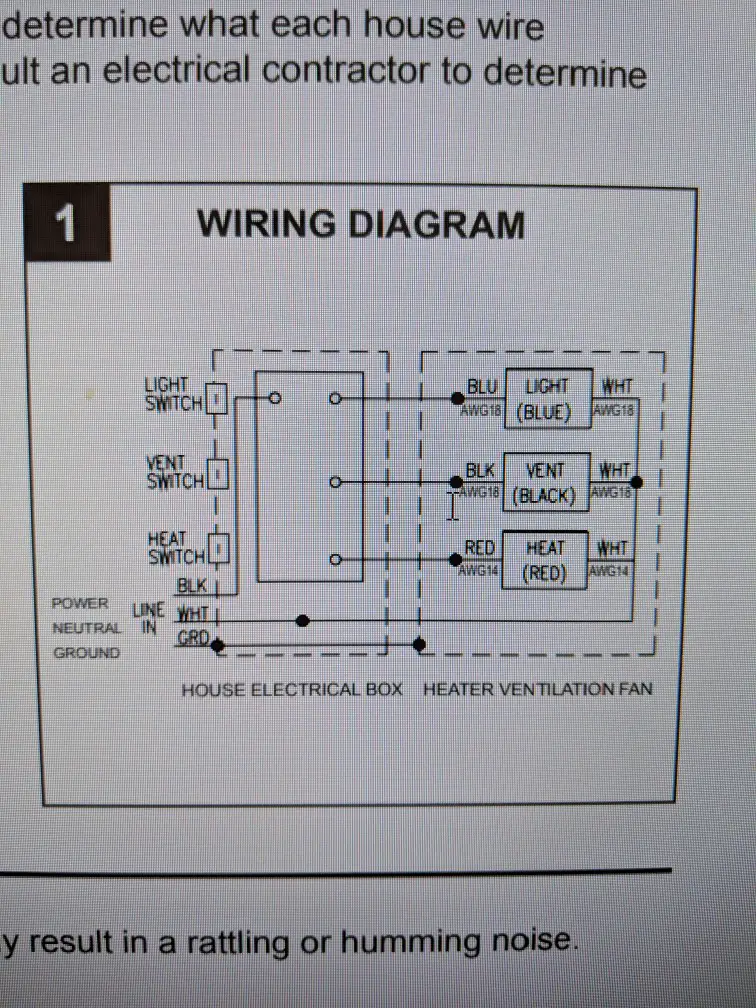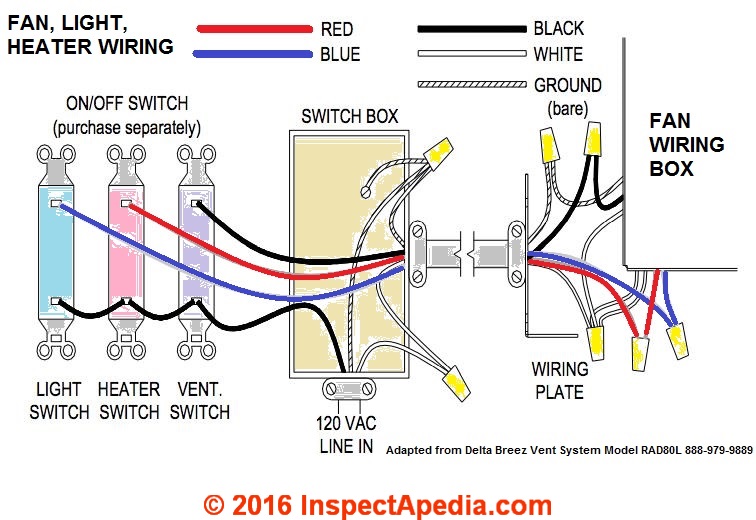To wire a bathroom exhaust fan with light and heater, connect the black wire to the hot side of the switch and the black from the housing. Then, connect the white wire, ground wire, and tuck wires inside the electrical box before putting the box back on.
Installing a bathroom exhaust fan with light and heater involves proper electrical connections to ensure safe and efficient operation. By following the correct wiring procedures as specified by the manufacturer, you can enjoy a well-ventilated and comfortable bathroom environment. Additionally, understanding the functionality of the different components such as the fan, light, and heater will help in optimizing their performance and energy efficiency.
Proper wiring not only ensures functionality but also guarantees the safety of the electrical system in your bathroom.

Understanding Wiring Basics
When wiring a bathroom exhaust fan with light and heater, it is crucial to have a solid understanding of the basics of electrical wiring. This knowledge will help ensure a safe and properly functioning installation.
Identifying Wires
Before starting the wiring process, it’s important to identify the different wires involved. Here are the common wire colors typically found in electrical wiring:
| Wire Color | Meaning |
|---|---|
| Black | Main Hot Wire |
| White | Neutral Wire |
| Green or Bare Copper | Ground Wire |
Following Electrical Code Regulations
Adhering to electrical code regulations is essential to ensure safety and compliance. Here are some key points to consider when wiring a bathroom exhaust fan with light and heater:
- Each component should be on a separate circuit for safety.
- Use a Ground Fault Circuit Interrupter (GFCI) for added protection.
- Follow manufacturer instructions for proper wiring methods.
A proper understanding of wiring basics and adherence to electrical codes will help you successfully wire a bathroom exhaust fan with light and heater.

Credit: inspectapedia.com
Determining The Circuit Needs
Introductory paragraphIn the process of wiring a bathroom exhaust fan with light and heater, it is crucial to assess the circuit requirements accurately. By understanding the existing circuits and deciding whether to have separate circuits for the heater, light, and fan, you can ensure efficient and safe electrical installation.
H3 – Assessing Existing CircuitsAssessing Existing Circuits
Before proceeding with the installation, it is essential to evaluate the current electrical circuits in your bathroom. Identify the circuit that powers the existing fixtures and determine if it has the capacity to support the additional load of the new exhaust fan with light and heater.
H3 – Considering Separate Circuits for Heater, Light, and FanConsidering Separate Circuits For Heater, Light, And Fan
- Separate circuits for each component can prevent overload and ensure proper functioning.
- Dedicated circuits for the heater, light, and fan offer more control and help in troubleshooting any future issues.
- Individual circuits allow you to operate each function independently for better energy efficiency.
Installing The Exhaust Fan With Light And Heater
When installing an exhaust fan with light and heater in the bathroom, ensure proper wiring for each component. Connect the fan, light, and heater to separate switches for efficient control. Use white wires for neutral and black wires for power, following electrical safety guidelines.
Preparation And Safety Measures
Before starting the installation process, ensure that the electricity is turned off to the bathroom. This can be done by switching off the relevant circuit breaker. Use a voltage tester to double-check that the power is indeed off. It is vital to take safety precautions such as wearing insulated gloves and using appropriate tools. Additionally, make sure the fan, light, and heater unit is suitable for the bathroom size and complies with all safety regulations.
Mounting The Unit
Start by selecting an ideal location for the fan with light and heater unit. Make sure it is away from any water sources and can effectively distribute heat and light. Mount the unit securely on the ceiling using the provided hardware. Ensure it is level and tightly secured to prevent any movement.
Wiring Connections
Carefully follow the manufacturer’s instructions and review the wiring diagram before starting the connections. Connect the electrical wires as per the guidelines to ensure a safe and efficient setup. Use wire nuts to secure the connections and double-check that all wires are properly insulated. Once everything is connected, test the fan, light, and heater to confirm they are functioning correctly.

Credit: m.youtube.com
Testing And Troubleshooting
Conducting Electrical Tests
Before installing and using the bathroom exhaust fan with light and heater, it’s essential to conduct electrical tests to ensure proper functionality and safety. Here are the tests you need to perform:
- Test the voltage: Use a voltage tester to check the voltage supply in the switch box to ensure it matches the fan’s electrical requirements.
- Test the switches: Turn on and off each switch individually to ensure they control the correct function of the fan, the light, and the heater.
- Test the fan: Turn on the fan switch and make sure the fan spins freely and operates smoothly. If there are any strange noises or if the fan doesn’t work, it may require further troubleshooting.
- Test the light: Turn on the light switch and make sure the light illuminates properly. If there is any flickering or if the light doesn’t work, check the wiring connections and replace the light bulb if necessary.
- Test the heater: Turn on the heater switch and verify that it produces heat. Allow it to run for a few minutes and check if the temperature rises accordingly. If there is no heat or if the heater malfunctions, additional troubleshooting may be required.
Common Wiring Issues And Solutions
While wiring a bathroom exhaust fan with light and heater, there are some common issues you might encounter. Here are a few of them, along with their solutions:
| Issue | Solution |
|---|---|
| The fan, light, or heater doesn’t turn on | Check the switch connections and make sure the power is reaching the fan. Inspect the wiring for any loose or damaged connections. Replace faulty switches or wiring as necessary. |
| The fan, light, or heater operates intermittently | Inspect the wiring connections for any loose or corroded terminals. Tighten or replace the connections as needed. Ensure the switches are functioning properly by testing them individually. |
| The fan, light, or heater produces a buzzing sound | Check for loose or faulty wiring connections. Make sure the wiring is properly grounded. If the issue persists, consider consulting a professional electrician. |
| The fan, light, or heater overheats | Verify that the wiring matches the fan’s specifications and that the circuit is not overloaded. Check for any obstructions that may be blocking proper ventilation. If the issue persists, consult an electrician. |
By conducting electrical tests and troubleshooting common wiring issues, you can ensure a safe and functional bathroom exhaust fan with light and heater installation. Remember to always follow proper safety precautions and consult a professional if you’re uncertain or uncomfortable with any electrical work.
Additional Tips And Considerations
When wiring a bathroom exhaust fan with a light and heater, remember to connect each component to the appropriate power source for safe and efficient operation. Separate switches for each function ensure customized control and ease of use. Proper grounding and wire connections are vital for a successful installation.
Selecting Suitable Fixtures
When it comes to selecting fixtures for your bathroom exhaust fan with light and heater, it is important to choose ones that are suitable for your needs. Consider the size of your bathroom and the amount of ventilation required. Look for fixtures that are energy-efficient and durable, as they will ensure efficient operation and longevity.
Additionally, make sure to check the wattage and voltage requirements of the fixtures to ensure compatibility with your electrical system. Consult the manufacturer’s instructions and specifications to determine the appropriate fixtures for your bathroom.
Maintenance And Upkeep
Maintenance and upkeep play a crucial role in ensuring the longevity and efficient operation of your bathroom exhaust fan with light and heater. Regular cleaning of the fan blades, grille, and housing will help prevent the buildup of dust and debris, which can hinder the fan’s performance.
In addition, it is important to check and replace the filters regularly to maintain optimal airflow and ventilation. Dirty filters can reduce the efficiency of the fan and lead to poor air quality in the bathroom. Refer to the manufacturer’s instructions for the recommended maintenance schedule and procedures.
Furthermore, inspect the electrical connections periodically to ensure they are secure and free from damage. Loose or faulty connections can affect the functionality of the fan, light, and heater. If you notice any issues, such as flickering lights or malfunctioning fan or heater, it is advisable to call a professional electrician to inspect and repair the system.
In conclusion, selecting suitable fixtures and regular maintenance are key to ensuring the proper functioning and longevity of your bathroom exhaust fan with light and heater. By following these additional tips and considerations, you can enjoy a comfortable and well-ventilated bathroom for years to come.

Credit: diy.stackexchange.com
Frequently Asked Questions On How To Wire A Bathroom Exhaust Fan With Light And Heater
Can You Run A Bathroom Fan And Heater At The Same Time?
Yes, you can run a bathroom fan and heater simultaneously, but they should be on separate electrical circuits.
Does Bathroom Exhaust Fan With Heater Need Its Own Circuit?
Yes, a bathroom exhaust fan with a heater needs its own dedicated circuit.
How To Wire A Bathroom Fan Heater?
To wire a bathroom fan heater, follow these steps: 1. Connect the black wire from the fan to the hot side of the switch. 2. Connect the black wire from the housing to the black wire of the fan. 3. Make wire connections and secure them.
4. Connect the white wire to the white wires of the circuit. 5. Make sure to tuck wires inside the electrical box and securely close it. These steps will ensure proper wiring for your bathroom fan heater.
How Do Bathroom Exhaust Fans With Heaters Work?
Bathroom exhaust fans with heaters work by using small infrared heat lamps that provide warmth and help maintain a slightly higher temperature in the space. They also help remove excess humidity and moisture more efficiently than using just the fan alone.
This is especially beneficial in homes with multiple occupants.
Can I Run A Bathroom Fan And Heater Simultaneously?
Yes, you can run a bathroom fan and heater simultaneously for efficient ventilation and warmth.
Conclusion
Wiring a bathroom exhaust fan with light and heater requires careful planning and following safety standards. Proper installation involves connecting the electrical wires, securing the components, and testing the functionality. With the right tools and knowledge, you can create a comfortable and well-ventilated bathroom space.
For more detailed instructions, refer to trusted sources and seek professional assistance if needed.